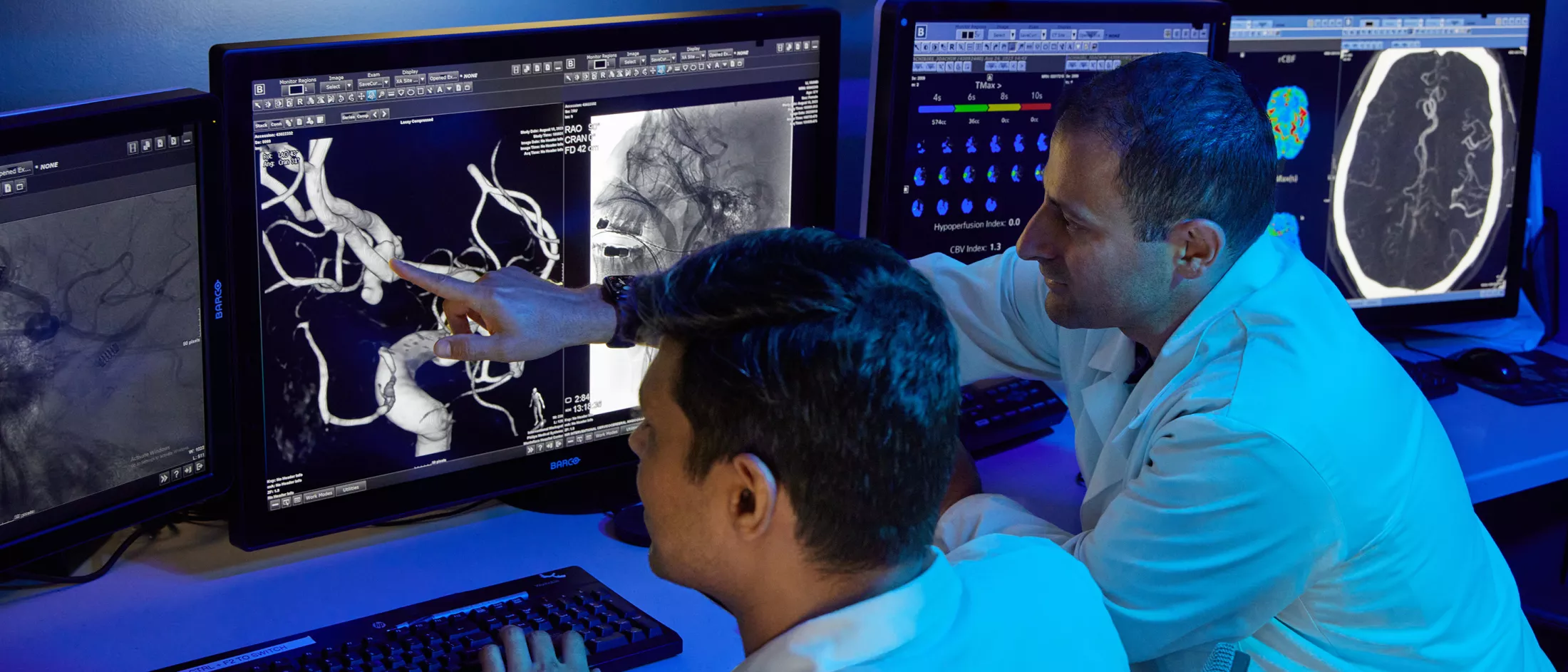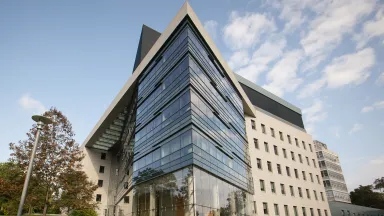Program Overview
An internationally recognized leader in stroke research, we are spearheading and participating in numerous clinical trials to advance promising interventions for stroke prevention, treatment, recovery and rehabilitation for patients with or at risk of a stroke across all stages of life.
Montefiore Einstein is a founding partner and key member of the New York City Collaborative Regional Coordinating Center (NYCC-RCC), the largest National Institutes of Health (NIH)-funded multi-institutional consortium dedicated to stroke prevention, treatment, education and rehabilitation efforts to reduce the burden of stroke on children and adults throughout the country. Distinguished as an inaugural NIH StrokeNet Regional Coordinating Center—since the inception of this highly competitive NIH initiative (StrokeNet) in 2013—we are among an elite group of only 27 centers in the nation to be awarded a five-year grant funded by the National Institute of Neurological Disorders and Stroke (NINDS). We continue to develop interdisciplinary endovascular platforms, new devices and intersectional strategies for conducting ultra-rapid clinical trials.
A collaborative effort between the NIH and Montefiore Einstein, the Icahn School of Medicine at Mount Sinai, New York University School of Medicine and other affiliated institutions and partner sites, our Regional Coordinating Center encompasses all boroughs of New York City, Westchester, Long Island and Upstate New York, as well as Nashville, Tennessee, and we continue to expand our network, leadership, and influence.
The Montefiore Einstein component encompasses an integrated 13-hospital healthcare system linked by telehealth technologies, that spans the Bronx, Westchester County, the Hudson Valley, as well as Rockland and Orange counties.

Areas of Concentration
Our scientists and researchers are conducting basic, translational and clinical research in stroke as well as other neurovascular conditions, studying stroke prevention; treatment and rehabilitation interventions; post-stroke outcomes; the role of rare causes of stroke—including varicella zoster, hypercoagulability, carotid web and aortic arch anatomy—as well as stroke disparities, and novel associations between COVID-19 and stroke.
Current Projects & Initiatives
Our investigators are currently involved in neurovascular research focused on stroke epidemiology, prevention, treatment, recovery, rehabilitation and stroke disparities.
StrokeNet Trials: Ischemic Stroke
Regarding ischemic stroke, we are participating in the following studies:
Sleep SMART (Sleep for Stroke Management and Recovery) Trial: Multicenter, prospective randomized trial, testing whether treatment of obstructive sleep apnea (OSA) with continuous positive airway pressure (CPAP) is effective for secondary prevention and recovery after stroke.
CAPTIVA (Comparison of Anti-Coagulation and Anti-Platelet Therapies for Intracranial Vascular Atherostenosis) Trial: Multicenter study to determine if novel antithrombotic medications are superior to standard care antiplatelet medications for lowering the one-year rate of ischemic stroke, intracerebral hemorrhage, or vascular death in patients with narrowed brain arteries.
VERIFY (Validation of Early Prognostic Data for Recovery Outcome after Stroke for Future, Higher Yield Trials): Study, in collaboration with our colleagues at the Physical Medicine and Rehabilitation Department, investigates the hypothesis that patients have different upper extremity motor outcomes depending on corticomotor system (CMS) function, measured with TMS, and corticospinal tract (CST) injury, measured with MRI at the time of an acute stroke.
StrokeNet Trials: Intracerebral Hemorrhage
Regarding intracerebral hemorrhage (ICH), we are participating in the following studies:
ASPIRE (Anticoagulation for Stroke Prevention and Recovery After ICH): Randomized phase III clinical trial testing the safety and efficacy of anticoagulation, compared with aspirin, in patients with a recent ICH and nonvalvular atrial fibrillation.
SATURN (Statins in Intracerebral Hemorrhage): Multicenter prospective randomized trial to determine whether continuation versus discontinuation of statin drugs, after spontaneous lobar ICH, is the best strategy and whether the decision to continue or discontinue statins should be influenced by an individual’s apolipoprotein-E genotype.
Non-StrokeNet Trials
Some of our non-StrokeNet clinical trial research addresses the minimally-invasive surgical management of ICH, brain aneurysms, AVMs, and normal pressure hydrocephalus, as well as the impact of the awareness of an untreated unruptured intracranial aneurysm, and post-stroke cognitive outcomes.
DISCOVERY (Determinants of Incident Stroke Cognitive Outcomes and Vascular Effects on Recovery): NIH-funded prospective, multi-center, observational study enrolling patients with acute ischemic stroke or intracerebral hemorrhage to understand what factors contribute to changes in cognitive abilities in patients who experienced a stroke, and to identify patients at risk for dementia.
ENRICH (Early Minimally Invasive Removal of ICH): Multicenter, randomized control trial for the surgical evacuation of intracerebral hemorrhage (ICH) using a minimally invasive parafascicular surgical technique. We completed the first successful trial in history for ICH, demonstrating the overall functional recovery and survival benefits of its surgical removal. This revolutionary trial has pioneered the treatment of patients with ICH, and places Montefiore Einstein at the forefront of this life-saving treatment.
We are one of only five sites in the nation participating in a prospective multicenter study evaluating the safety and effectiveness of the e-Shunt system, a novel minimally invasive endovascular approach, for the treatment of adults with normal pressure hydrocephalus, to reduce disability and improve patient comfort, cognitive ability, and quality of life.
We are spearheading the Psychiatric Outcomes of Unruptured Intracranial Aneurysms (POUIA) clinical trial, a prospective cohort study investigating the impact of the awareness of an untreated unruptured intracranial aneurysm on the psychiatric and mental status of patients treated with conservative management/observation, compared with those treated with microsurgical and endovascular interventions.
We are conducting numerous clinical trials evaluating the safety and efficacy of newly emerging endovascular flow disruptor technologies for brain aneurysm treatments to achieve better and safer patient outcomes.
We are participating in the TATAM trial, a multicenter, randomized control clinical trial investigating transvenous embolization, a new endovascular approach for treating cerebral arteriovenous malformations (AVMs). This novel transvenous technique may offer unique advantages over the transarterial approach to AVM embolization, which historically has had a low overall rate of occlusion and provides a new option to cure previously untreatable AVMs.
Rare Causes of Stroke
In collaboration with neuroradiology and vascular surgery, our center has published research on strokes related to carotid webs, carotid atherothrombosis, and aortic arch anatomy. Our expertise in hypercoagulability and stroke in young individuals has provided additional valuable contributions to the broader field of stroke research. Through extensive data analysis—from our large cohort of patients with confirmed cerebral varicella zoster virus (VZV) vasculopathy—we have contributed valuable insights on the role of VZV in stroke.
After publishing the largest US epidemiologic study assessing the prevalence of carotid webs in 2021, we continue to lead the way by studying one of the largest hospital-based cohorts of patients with strokes related to carotid webs. Additionally, we are further investigating how these rare and under-recognized shelf-like carotid artery webs cause ischemic stroke, and why they most commonly occur in healthy younger women.
Stroke Anatomy Atlas
The Division of Vascular Neurology has developed three-dimensional vascular maps that are revolutionizing stroke care. These maps can be explored online in 3D, providing a unique resource for neurology trainees, faculty and practicing neurologists. Please visit www.stroke-maps.org to view our three-dimensional vascular maps of the brain.
Stroke Disparities
The Montefiore Comprehensive Center for Stroke Care strives to close the gap in racial and ethnic stroke disparities. Our specialists have published on many topics in the field of stroke disparities:
- Anticoagulation in atrial fibrillation
- Underutilization of thrombectomy
- Differences in moya moya prevalence
COVID-19 Associated Stroke Risk
Montefiore Comprehensive Center for Stroke Care specialists have published on many topics in the field of stroke disparities:
Neuromodulation for the Management of Post-Stroke Motor Impairment
In collaboration with our Burke Rehabilitation Hospital, we have also launched a new research and treatment program for chronic stroke patients with upper extremity motor impairment, and delayed recovery pairing vagal nerve stimulation with a 6-week intensive rehabilitation program, to improve arm and hand function in patients previously disabled by ischemic stroke.
MRI Study of Hydrogen Water & Minocycline Combination Therapy for Ischemic Stroke
We are spearheading NINDS/NIH-funded research aimed at identifying innovative multimodal MRI approaches to determine tissue viability and cerebral functional status. This will allow us to evaluate the efficacy and therapeutic effects of combined hydrogen water and minocycline, on ischemic stroke, in the established middle cerebral artery occlusion, employing small animal stroke models.






